Are you a Quiet Speculation member?
If not, now is a perfect time to join up! Our powerful tools, breaking-news analysis, and exclusive Discord channel will make sure you stay up to date and ahead of the curve.
Welcome to no-Eldrazi Monday, where I scour the Modern environment for anything to discuss that isn't colorless and didn't skip leg day. Just kidding: even Legacy saw its reality smashed by Eldrazi taking the top Day 2 metagame slot at the StarCityGames Philadelphia Open. I'm having Treasure Cruise flashbacks and April can't come soon enough. Eldrazi could claim a mere 10% of the upcoming Grand Prix weekend, a gross improbability representing a 50% drop from its paper prevalence and an unbelievable 80% dip from SCG Louisville, and the deck would still prove itself one of the most format-warping forces in Magic history. At this point, the question "Will there be an April ban" has, for all intents and purposes, given way to "How many Eldrazi bans will we see in April?" I'm betting on two at this rate. That said, because it's "no-Eldrazi Monday," I'm tabling the world-breaking tribe and talking about a more forward-looking aspect of Modern: card evaluation and new sets.
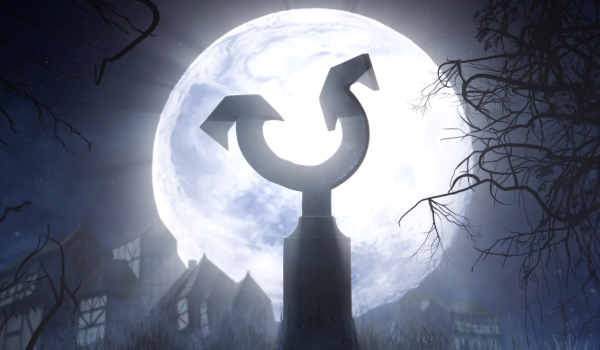
We're already getting the first Shadows Over Innistrad spoilers, and although Innocent Blood has yet to be spilled spoiled, I'm already getting excited. This excitement encompasses a strict upgrade to Ghostway, Clue tokens which thrill both the Arkham Horror and Shape Anew fan deep in my heart, the second-coming of madness (so long as that madness is more Edgar Allan Poe than H.P. Lovecraft), and a return to the best Magic art since, well, the last time we were on Innistrad. It also means we must evaluate 297 new cards and their Modern relevance. New card evaluation is challenging even in Standard where Wizards does the entirety of its Future Future League testing. Add the Modern cardpool, and it's no wonder some authors herald Narset, Transcendent as the next Jace, the Mind Sculptor while others never saw the Eldrazi apocalypse coming. Today, I'll explore a few guidelines I keep in mind when evaluating new cards, rules we can hopefully remember as Shadows spoilers formally commence in the next weeks.
[wp_ad_camp_1]
Know Format Context
I'm a man who loves him some metagame numbers, so it should come as no surprise I begin all my new card evaluation in the broader Modern context. Before you can even parse a single line of text on a shiny new spoiler, you'll need to understand these two facets of the overall Modern picture. If not, most of your evaluations will be dead on arrival.
When considering card evaluation, "Modern context" is disproportionately focused around Tier 1 decks. Metagame analysis takes the tiers more holistically, but we don't have that luxury when assessing new cards: the barrier to entry begins and ends with Tier 1. Operationalizing this, you'll need to consider all Tier 1 decks since the most recent banlist update. Sometimes, this will give us a whole year of data. Other times, we'll have only a few months, even weeks, to draw on. Either way, resources like our Top Decks page are an excellent place to look when trying to comprehend the broader metagame forces shaping card evaluation.
Knowing Tier 1 decks
Because these Tier 1 decks definitionally represent such a broad and important segment of the format, new cards must typically answer at least one of three questions with respect to those strategies. Here are those overarching questions, along with some sub-questions you should ask once you've identified the main role this card might fill.
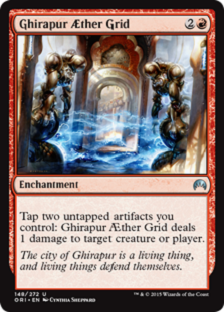 Does the card fit into an existing Tier 1 strategy?
Does the card fit into an existing Tier 1 strategy?
- Does it represent an upgrade to an existing effect in that strategy?
- For example, Roast replaces Flame Slash in UR decks to answer five toughness Tarmogoyfs, Tasigurs, and Rhinos.
- Does it add an effect the existing strategy wanted but lacked?
- For example, Harbinger of the Tides adds an interactive element to removal-lite Merfolk, disrupting creature-based combos and out-tempoing decks in a race.
- Does it repair a major weakness in that strategy?
- For example, Ghirapur Aether Grid offers Affinity a Plan B against Stony Silence
- Does it represent an upgrade to an existing effect in that strategy?
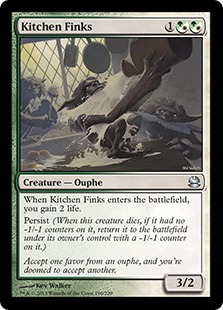 Does the card matchup favorably against multiple existing Tier 1 strategies?
Does the card matchup favorably against multiple existing Tier 1 strategies?
- Does it answer a specific type of threat across multiple matchups?
- For example, Anger of the Gods is a potent sweeper against Affinity, Abzan Company, Zoo, and others.
- Does it offer a major threat that different Tier 1 opponents will struggle to answer?
- For example, Kitchen Finks stymies aggressive, damage-based decks (Burn, Zoo) and stalls midrange ones (Jund, Abzan).
- Does it survive, or trade favorably with, the interaction commonly played by Tier 1 strategies?
- For example, at three mana, Jori En, Ruin Diver puts you down against every common removal spell in Tier 1 and is thus unplayable.
- Does it answer a specific type of threat across multiple matchups?
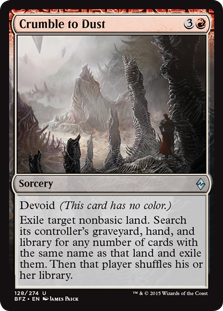 Does the card matchup decisively against one existing Tier 1 strategy?
Does the card matchup decisively against one existing Tier 1 strategy?
- Does it cripple the opposing Tier 1 deck's gameplan beyond reasonable recovery?
- For example, Crumble to Dust obliterates the RG Tron manabase.
- Does it represent an unanswerable threat to the Tier 1 deck?
- For example, Keranos, God of Storms wrecks BGx Midrange decks in the URx contest.
- Does it cripple the opposing Tier 1 deck's gameplan beyond reasonable recovery?
In the vast majority of cases, these questions alone will put you on the right track to properly evaluating a card. Of course, it's still possible to miss on your card evaluations by responding to the right questions with the wrong responses. No, Affinity does not want Ghostfire Blade. Ample testing and a competent understanding of Modern's mainstays can help you dodge these pitfalls. Also, as a general guideline, if you have to ask "Does Insert-Tier-1-Deck-Here want one of these?" then the answer is probably "Nope."
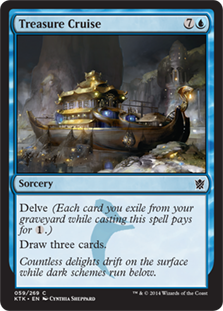 What about new cards that fundamentally alter the Modern landscape? I'm not talking Kalitas, Traitor of Ghet, which occupies a singleton Jund slot as a metagame-specific edge against Abzan Company and Arcbound Ravager. I'm talking Siege Rhinos and Thought-Knot Seers. In these outlying cases, are Tier 1 decks still important? Can't powerful new entrants disrupt the standing tiers and introduce new competitors? The answer to both questions is a resounding "Yes!" Even in the case of format-warping monsters, and even in the case of new decks, Tier 1 frequently carries most of its listings from one month to the next and is always the best place to start the evaluation process.
What about new cards that fundamentally alter the Modern landscape? I'm not talking Kalitas, Traitor of Ghet, which occupies a singleton Jund slot as a metagame-specific edge against Abzan Company and Arcbound Ravager. I'm talking Siege Rhinos and Thought-Knot Seers. In these outlying cases, are Tier 1 decks still important? Can't powerful new entrants disrupt the standing tiers and introduce new competitors? The answer to both questions is a resounding "Yes!" Even in the case of format-warping monsters, and even in the case of new decks, Tier 1 frequently carries most of its listings from one month to the next and is always the best place to start the evaluation process.
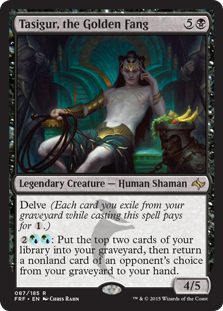 In the case where Treasure Cruise 2.0 sails through development into Modern, the upstart Cruise-powered strategies are still building from the old guard. Fall 2014 saw Cruise slot into Burn, an existing Tier 1 strategy, and URx Delver, an existing Tier 2 player. Kolaghan's Command and Tasigur, the Golden Fang of early 2015 outright created a Grixis Control/Midrange strategy where none had previously existed in any serious competitive sense (sorry, Cruel Ultimatum proponents). Even so, this new Grixis deck still arose out of the context of other Tier 1 strategies that had been around for months. In the case of Cruise, the new cards empowered old, top-tier decks. In the case of Grixis staples, the new cards allowed a new strategy to excel as part of a preexisting context. We even see this today in Modern's most warped moment, where Tier 0 Eldrazi still share chart placement with Tier 1 mainstays Jund, Affinity, Burn, and others.
In the case where Treasure Cruise 2.0 sails through development into Modern, the upstart Cruise-powered strategies are still building from the old guard. Fall 2014 saw Cruise slot into Burn, an existing Tier 1 strategy, and URx Delver, an existing Tier 2 player. Kolaghan's Command and Tasigur, the Golden Fang of early 2015 outright created a Grixis Control/Midrange strategy where none had previously existed in any serious competitive sense (sorry, Cruel Ultimatum proponents). Even so, this new Grixis deck still arose out of the context of other Tier 1 strategies that had been around for months. In the case of Cruise, the new cards empowered old, top-tier decks. In the case of Grixis staples, the new cards allowed a new strategy to excel as part of a preexisting context. We even see this today in Modern's most warped moment, where Tier 0 Eldrazi still share chart placement with Tier 1 mainstays Jund, Affinity, Burn, and others.
Whether you're considering marginal edges like Natural State, or Modern-altering force of natures such as the infect mechanic, start in the Tier 1 decks. Although you can find application in Tier 2 and lower, it's in Tier 1 that the overwhelming majority of new Modern candidates will make it or break it. In the spirit of this political month, think of Tier 1 like the Super Tuesday of the card evaluation process. New cards can still win in Modern without carrying (or being carried by) Tier 1 decks, but it's an uphill struggle. Remember this the next time you vouch for Ayli, Eternal Pilgrim breaking Tier 3 Soul Sisters, or Nissa, Voice of Zendikar enabling Tier Nothing GWx Tokens. Don't take that too personally: I'm a fellow with an admitted fondness for Restore Balance, Goblin Charbelcher, and Enduring Ideal jank.
Mana Cost Matters
We're all Modern players, so we already have an appreciation of mana cost and its relationship to playability. This should be your second new-card stopping point after reading the text box twice (see Horribly Awry evaluation going horribly awry) and examining top-tier decks.
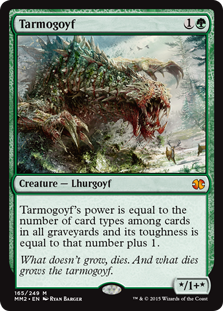 At its most basic level, Modern is a turn four format with a fundamental turn closer to 3.5. This is a Tarmogoyf format where two mana on a creature better get you a 4/5 beatstick or a 2/2 Goblin that wins the game for you if you can untap. This is a Lightning Bolt format where losing a Wild Nacatl at parity isn't the end of the world, but losing your turn three Glissa, the Traitor to a one-mana spell is fatal. In all these examples and countless unmentioned others, some combination of cards, decks, and precedent determines if cards are appropriately-priced relative to their casting costs. Ultimately, it's a relatively elementary calculation: better cards have more powerful effects at cheaper cost.
At its most basic level, Modern is a turn four format with a fundamental turn closer to 3.5. This is a Tarmogoyf format where two mana on a creature better get you a 4/5 beatstick or a 2/2 Goblin that wins the game for you if you can untap. This is a Lightning Bolt format where losing a Wild Nacatl at parity isn't the end of the world, but losing your turn three Glissa, the Traitor to a one-mana spell is fatal. In all these examples and countless unmentioned others, some combination of cards, decks, and precedent determines if cards are appropriately-priced relative to their casting costs. Ultimately, it's a relatively elementary calculation: better cards have more powerful effects at cheaper cost.
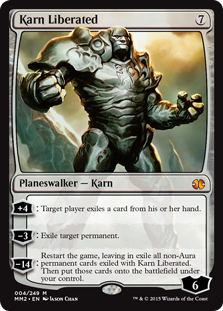 Complicating this picture, we've probably heard all the Modern tales about certain cards being unplayable over certain mana costs. Yes, cost alone is important, but without also considering our first questions of context, cost loses real-world meaning. An excellent example of this is Drowner of Hope, which is unplayable Limited fodder in a climate where Eldrazi Temple and Eye of Ugin don't exist to accelerate it out far ahead of its six-mana cost. Another example is Timmytastic Karn Liberated, which falls well outside the conventional playability range for most decks, except for the one Urza's Tower-powered deck where it shines. That said, no amount of favorable context will make some cards playable: poor six-mana Chandra, Flamecaller is bad in Modern no matter how you spin her.
Complicating this picture, we've probably heard all the Modern tales about certain cards being unplayable over certain mana costs. Yes, cost alone is important, but without also considering our first questions of context, cost loses real-world meaning. An excellent example of this is Drowner of Hope, which is unplayable Limited fodder in a climate where Eldrazi Temple and Eye of Ugin don't exist to accelerate it out far ahead of its six-mana cost. Another example is Timmytastic Karn Liberated, which falls well outside the conventional playability range for most decks, except for the one Urza's Tower-powered deck where it shines. That said, no amount of favorable context will make some cards playable: poor six-mana Chandra, Flamecaller is bad in Modern no matter how you spin her.
Considering these nuances, I like to start mulling over mana costs after I've addressed the more pressing questions of Tier 1 context. If I can answer "Yes" to both a main contextual question (e.g. "Does the card fit into an existing Tier 1 strategy?") followed by a sub-question (e.g. "Does it add an effect the existing strategy wanted but lacked?"), then I'll start to think how the mana cost makes that calculation more or less favorable for the new card in question. Some card evaluators prefer to consider the cost before thinking about context, but I find this gets us into trouble with deck-specific bombs.
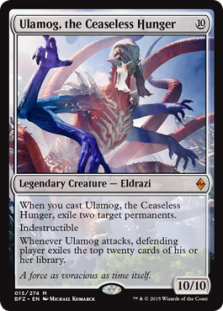 As an illustration of these dangers, Ulamog, the Ceaseless Hunger costs 10 mana, which is clearly unplayable in the average Modern deck and initially appears unplayable even in RG Tron, where Wurmcoil Engine and Karn are dropping on turn 3-4 at six and seven mana respectively. But in the context of the Tron engine, its cantrips, and its tutors, 10 mana is more than attainable on turn five and within reach as early a turn four. Add Ulamog's double Vindicate interaction even if it gets countered (and its virtual Remand immunity), and the card easily becomes a strategy-defining staple. This evaluation, as with many others, starts first in context before moving to cost, and is just one example of why I prefer this order.
As an illustration of these dangers, Ulamog, the Ceaseless Hunger costs 10 mana, which is clearly unplayable in the average Modern deck and initially appears unplayable even in RG Tron, where Wurmcoil Engine and Karn are dropping on turn 3-4 at six and seven mana respectively. But in the context of the Tron engine, its cantrips, and its tutors, 10 mana is more than attainable on turn five and within reach as early a turn four. Add Ulamog's double Vindicate interaction even if it gets countered (and its virtual Remand immunity), and the card easily becomes a strategy-defining staple. This evaluation, as with many others, starts first in context before moving to cost, and is just one example of why I prefer this order.
Card Evaluation Leading Into Shadows
Of course, the ultimate arbiter of new card evaluation is testing. Maybe a topic for the next no-Eldrazi Monday? Even if you only sleeve up for 5-6 Game 1 and Games 2-3 with a new card, you can almost always get a telling sense of the card's Modern fate. Don't have time to run a rigorous gauntlet? Don't be afraid to seed your new card in your opening hand just to test-run how the candidate works in an ideal world. Alone, this isn't the most scientific way to analyze a card, but it's far better than taking to the forums with categorical rejections of everything that dies to Lightning Bolt.
I'll be doing one last return to the Eldrazi menace before the Grand Prix weekend kicks off, which you can expect to see this coming Wednesday. Until then, let's stay optimistic for a more colorful Modern future, and let's start getting pumped for those Shadows Over Innistrad cards hitting the spoiler airwaves in the weeks to come. Let me know in the comments if you have any questions about card evaluation, new sets, specific cards, or how you are supposed to cope with the eldritch takeover of our format, and I'll see you all soon!





To be fair, “dies to lightning bolt” is a pretty huge deal.
You do need a creature and generates (or at least threatens to) generate a good value if you want to play a x/3. Given it’s pretty much THE reason to run red in your deck…
Or at least it was before modern went kaput and was replaced by the eldrazi format.
As BGx player, I’m looking forward to cards with the new dellirium mechanic. 4 card types in the grave is difficult at all.
4+ toughness is definitely a benchmark, but there are enough 2-3 CMC creatures with <4 toughness that are still quite playable in Modern. Of course, all of them are heavily dependent on context. This doesn't even include one-drops, which CAN be Boltable because then you're at least just losing a creature at parity. Two drops like Blighted Agent, Goblin Electromancer, Merfolk lords, Steel Overseer, Dark Confidant, and many more all theoretically fail the Bolt test but give you enough contextual value that it's okay. This is why I'm less worried about the Bolt test in itself and more worried about the Tier 1 context (followed closely by mana cost).
Can't wait for delirium either! Early spoilers are very promising.
Those 2-3cmc creatures generally provide a sizable upside if they live that outweigh the risk of them getting bolted. A confidant that lives quickly overwhelms opponents in card advantage, An electromancer that doesn’t die allows Storm to go off easier, Merfolk lords vastly increase the clock of their other creatures.
The bolt test is still a fundamental benchmark of the format because creatures need to have a certain “something-something” to them that outweighs the chance they just get bolted. That’s the primary reason Mantis Rider doesn’t get played, but Dark Confidant will.
These are good tips for evaluating a deck, Sheridan. I’ll keep them in mind when analyzing the Shadows over Innistrad spoilers. I’m particularly excited about cards such as Topplegeist, which seem to be pushing the boundaries of how much utility functions can be packed into a 1-drop. I’m hoping it could find a home in decks like Death & Taxes, which is hanging out around in the fringes of Tier 3, but has the potential to rise (especially since Topplegeist and Vial would make it pretty good at fending off Eldrazi attacks). What say you?
Love Topplegeist abstractly. Unfortunately, it’s much harder for the decks that want it (D&T, Hatebears) to activate delirium naturally. You basically need to rely on an opponent doing it, because those decks are going to be lucky to have lands and instants in their yard if anything at all.
That said, I am very excited to see delirium interact with tribal cards like Jordan’s favorite Peppersmoke and Tarfire. Maybe I’l start playing Warren Weirding again!
Sadly delirium will only check your graveyard. You’re on your own to get the 4 card types.
Sorry, this was unclear. As in, you need to rely on an opponent putting extra stuff in your yard, like blowing up your Vial or killing your creatures.
Getting delirium up is definitely an issue for D&T/Hatebears, but in my experience an opponent that does not kill their creatures is an opponent that loses the game. Additionally, the fact that Topplegeist taps a creature as an ETB effect makes it not a dead topdeck, which is more than the other 1-drops those decks employ can say. I’d consider the Delirium a nice bonus that you’d get in grindy games, and most evaluate it as a 1/1 flier for W that taps something as an ETB. I think that’s enough to get it some run.
Anyone else excited about the new blue goyf, Thing in the Ice?! It doesn’t die to bolt, not to hard to flip, and even cyclonic rifts their non-spellskite creatures!
http://mythicspoiler.com/soi/cards/thingintheice.html
Here’s what I want out of SOI:
Something’s Denial 1UU
Instant
Counter target Spell
Investigate
They asked, and he said “no”.